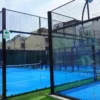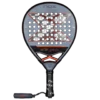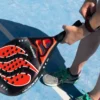Check out our latest additions to the websites - if you're looking for rackets, balls, bags or clothing - Gear up for victory!
Shop NowWhether you are getting ready for an intense gym session or walking into the sports field, the importance of warm-ups is sky-high. It’s not just essential to escape the thin line of potential injuries, but it can also significantly elevate your performance on the field.
So, when you are playing Padel, no matter what your level or skill set is, doing the right Padel warm ups is super important. Just ten to twenty minutes of Padel warm-up drills can help you be in control, move better, and react more effectively during the game.
In case you are still wondering which padel warmups you should add to your regime and how they can shape your overall gameplay, this article will guide you. Here we will talk about everything you need to know about Padel warmups.
Table of Contents
General padel warm ups
Have you seen the professional players moving like bullets on the Padel court right from the start of the game? Curious to know what’s the secret? They get an instant boost in speed and amazing mobility due to proper padel warmups.
A good ten to fifteen minutes of warm-up is the foundation of a great padel match. It keeps you a million miles away from injuries. Proper padel warmups prepare your muscles and joints for the coming intense load during the session.
So, what are the Padel warm-up drills you should add to your regime? Here are some essential padel warm-up exercises you can’t miss out on:
Jogging
Padel warmups do not include many fancy exercises. A simple five minutes of jogging can help your body get active. It can increase your blood circulation and loosen your leg muscles. You can either jog on the paddle court or any other place just for five minutes and reap the benefits during the session.
Here are the perks you can claim with just five minutes of jogging before the game:
- Improve endurance
- Reduce muscle stiffness
- Level up in overall agility
Skipping Rope
We all have tried this in our childhood, and the best part is it’s an absolutely amazing padel warmup. It’s a great cardio exercise that builds a strong coordination of your feet and arms. That’s not all. It also strengthens your arms and calves and cuts off risks of ankle injuries.
Check out the benefits of just five to ten minutes of skipping ropes before a padel session:
- Better balance and agility
- Strengthened lower leg muscles
- Level up in cardiovascular endurance
High Knees
Your legs play the most important part during a padel session. So, you need to prepare them to absorb the shock before an intense session. High knees can be an amazing option to get your legs and core engaged. It stimulates your cardiovascular activities.
Here are the benefits of doing high knee exercises before a padel session:
- Improved knee lift for swift movement
- Strengthen core and leg muscles
- Enhanced coordination and speed
Arm Circles & Shoulder Rolls
You need to repetitively move your arms and shoulders during a padel session. That’s why warming them up is super important. Doing small and large arm circles prepares your rotator cuffs for those aggressive padel smashes.
Here are the benefits you can potentially gain from doing these padel warmups:
- Prevent shoulder strain or injuries.
- Get better shoulder flexibility.
- Improve swing control.
Padel Warm Up Stretches
Done with the basic padel warmups? Now it’s time to take it to the next level. To completely prepare your body for an intense padel session, you need to add both static and dynamic padel stretches into your regime. A blend of both will ensure improved flexibility and prevent you from injuries. So, here are the padel warm up stretches you must dip your hands into:
Dynamic Stretching
Just a few minutes of dynamic stretching can help you prevent injuries on the padel field. To start with, you can try leg swings, which will loosen your hip flexors and hamstrings. To perform this stretch, just stand next to any wall and get support. Next, swing one leg forward and backward. That’s it.
Another great dynamic stretch is rotating your shoulders. The padel game heavily relies on the shoulders. So, you can do arm rotations and even shoulder stretches to activate the muscles.
Padel players rely heavily on shoulder strength for powerful smashes and volleys. Arm circles and shoulder rotations prepare the upper body for intense movements.
Here are the benefits you can enjoy with dynamic stretching:
- Improves hip mobility.
- Boost your balance and coordination.
- Reduces the risk of hamstring and shoulder injuries.
- Prepare your arms for quick movements.
Static Stretching
The importance of static stretching poses the same weight as dynamic stretching. To start with static stretching, you can do standing quad stretches. Just stand on one leg, hold your ankle, and pull it towards your glutes. It’s that simple. This exercise will make your quads and lower body much more flexible and stronger.
Another great static stretching exercise is calf stretches. It’s super important to have strong calves, as you need to move quickly on the paddle field and make regular direction changes. So, just place your hands against a wall, go one foot back, and push your heel into the ground. This is how you can train your calves for an intense padel session.
Here are the benefits of doing static stretching before playing a padel game:
- Prevent knee injuries.
- Enhance flexibility for quick movements.
- Cuts off the threat of Achilles tendon injuries.
- Enhance foot speed and agility.
Padel warm up drills
Once your body is ready to take the upcoming strains during a padel session, it’s time to focus on racket control and coordination. You must try padel warm up drills. These will help refine your touch, enhance your reaction speed, and get you ready for the match.
Here are the padel warm-up drills you must do:
Mini Rallies at the Net
Before you get into the long padel rallies. Make sure to start with mini rallies on the net. Just stand close to the net with your partner or opponent and start a controlled volley back and forth. Let the ball bounce and keep an eye on it. This is increasing your focus and accuracy.
Here are the benefits mini rallies offer:
- They will improve your hand-eye coordination.
- They will help you develop better touch and control over the ball.
- They will warm up your wrists and forearms.
Wall Rebounds
Don’t have a partner to warm up? No issues. Use a wall. You can hit the padel ball against the wall and try your shots on it. However, try to maintain a rhythm and hit the fall properly.
Here are the perks you can claim with just a few minutes of wall rebound hitting:
- It will enhance your reaction time.
- You can try and master different shots.
- It will strengthen your wrist control.
- You can learn how to make better placements.
Quick Reflex Volleys
Sometimes you need to be super fast on the court. Quick and aggressive shots can take you to a better position in some matches. So, practice quick reflex volleys. Stand super close to the net and hit the ball harder towards your partner. If you don’t have one, you can also do this using a wall.
Here are the benefits of quick reflex volleys:
- It will sharpen your reflexes for fast exchanges.
- It will help you develop better control.
- It will boost your decision-making and shot-selection skills.
Other padel warm up exercises
General padel warm ups and stretches are great to get started. However, to go a step ahead of the competition, you can add some strength-based exercises to your regime. These will help you target the essential padel muscle groups.
Here are the exercises or warm-ups to include:
Squats
Just do 10 to 15 repetitions of squats, and it will prepare your lower body for a padel session.
Here are the benefits of doing squats:
- Elevate your lower body strength.
- Boost your lower body balance and stability.
- Cut off the risk of knee and ankle injuries.
Lunges
Leg strength is a must for playing padel, and lunges are great to build that. Simply take a single-leg step forward, bring your back knee near to the floor, and then push yourself back up.
Here are the benefits of doing lunges before a padel session:
- It strengthens your quads, hamstrings, and glutes.
- It improves the agility for quick lateral movements.
- Boosts your overall coordination and stability.
Planks
In padel, stability and shot accuracy depend heavily on a strong core. So, make sure to develop a solid core by doing planks.
Here are the advantages of doing planks:
- It makes the core stronger for improved balance.
- It increases stamina for long padel sessions.
- It works well for lower back support and injury prevention.
Mental preparation before a game
Just having the perfect body condition is not enough to play padel like a pro. To play effectively, one must have a strong mindset too. So, how to build a mind that complements your body during a padel session to deliver the best?
To increase confidence, begin by visualizing yourself dominating the game, making shots, and scoring points. To maintain your composure, practice regulated breathing exercises. Another great move is constructive self-talk. It will take your confidence to the next level. Also, make sure to keep your mind focused on the game and stay away from distractions.
Summary
Want to have a long padel career or stay away from injuries? Then, a proper warm-up routine is a must. Start with general padel warm-up exercises and then slowly move to padel warm up stretches. Doing all these the right way will ensure you deliver the best on the field and stay hundreds of miles away from severe injuries. So, enjoy the game the right way!
Frequently Asked Questions (FAQs)
Q. Why should I do padel warm up exercises?
Padel warm ups free your muscles and joints and prepare them for an intense session. This prevents injuries and ensures you deliver optimum performance on the field.
Q. How long should a padel warm-up take?
A good warm-up routine will take around 15 to 20 minutes. Don’t overdo it, as it may exhaust your body.
Q. What happens if I skip my warm-up?
Ignoring your warm-up makes it harder to perform well right from the beginning of the game, lowers flexibility, and increases the chance of injury.
Read more:





